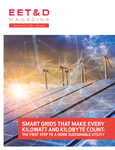After experiencing a long, hot summer, utilities and grid operators across the United States are understandably apprehensive. Searing summer heat, severe drought conditions and an above-normal hurricane season, coupled with a surge in electric demand higher than pre-pandemic levels, electric capacity shortfalls and aging plant infrastructure, will further expose the need for grid modernization to improve resiliency.
This is why the nation’s power grid must become smarter, digitalized and more participatory through the adoption of new solutions and cutting-edge technologies, equipment and controls like Digital Twin software and advanced distribution automation.
An urgent, aggressive commitment by utilities and grid operators to implement smart grids and new digital technologies, equipment and controls will be key to creating more resiliency. Digitizing the grid takes time and if utilities and grid operators don’t act now then the U.S. will only fall further behind. With smart grids and new digital solutions, the U.S. power grid will be better able to withstand more extreme weather and big demand and supply swings while advancing the nation toward a fully electrified, sustainable future.
Climate change and ever-increasing grid vulnerabilities
A focus on grid resiliency is especially critical given the ever-increasing grid vulnerabilities, including impacts of climate change which manifest as extreme weather, heat and drought. These conditions can disrupt electricity flow to households across the U.S. while costs climb and, most importantly, put American lives at risk.
Lake Powell gave us a preview of what is coming this summer when in May of this year, the nation’s second-largest reservoir, supplying water and hydroelectric power to millions across the West plummeted to its lowest level ever. The National Oceanic and Atmospheric Administration (NOAA) forecasts that almost all of the contiguous US will experience above-normal temperatures, which combined with below-average rainfall, creates a recipe for ongoing megadrought conditions.
Beyond the effects of climate change, the U.S. is projected to experience significant electric capacity shortfalls due to aging infrastructure and power plant retirements. In fact, the North American Electric Reliability Corporation (NERC) reported in its summer reliability assessment that the Midcontinent Independent Systems Operator (MISO) in particular, will face a 1.7% increase in peak demand with 2.3% less generation capacity than last year, resulting in high risk for energy emergencies during this summer peak. Other regions NERC flagged for capacity shortfalls due to extreme heat and drought conditions include Texas, the Missouri River Basin and the Western Interconnection.
Climate change and capacity shortfalls are a few of the critical factors underscoring the need to modernize the U.S. power grid with digital solutions, so it can withstand future weather events and mitigate power outages — while also saving lives, protecting property and keeping the economy running.
U.S. utilities and grid operators can improve grid resiliency now
As we move towards a fully electrified, sustainable future, utilities and grid operators need to be armed with intelligent digital solutions that address what is projected to be a summer of historic post-pandemic consumer demand and an increase in extreme weather, particularly hurricanes, heat waves and drought. These include technologies to digitize field operations, network infrastructure, meters and grids, as well as microgrids.
Metering and grid edge digitalization
Advanced metering infrastructure collects data that helps operators anticipate grid maintenance and faults to help keep the lights on when customers need them. Europe and Latin America are ahead of the curve in their adoption of advanced second-generation metering infrastructure and can serve as models for U.S. utilities and grid operators. Italy, for example, carried out a massive rollout of smart meters in the 2000s and is undergoing a second-generation roll-out with very advanced functionalities. The Brazilian city of São Paulo has also been installing smart meter solutions since 2021. Smart meter solutions allow customers more control over their consumption and make their electricity bills more transparent, which includes the ability for customers to manage their accounts and energy profiles through an app.
Network infrastructure digitalization
U.S. utilities and grid operators should also consider embracing virtualization technologies and decentralized computational capability that allow them to run critical grid functions while simultaneously reducing the number of necessary physical components. This, in turn, allows networks to operate at scale more efficiently and sustainably, even in the face of unpredictable weather and capacity shortfalls. Key functionalities for network infrastructure digitalization include metering data management, load profiling, power quality, asset health and performance monitoring and loss minimization.
Field operations digitalization
Digital Twin software for the grid is a new model created through artificial intelligence (AI) and drone scan data to replicate the entire network as well as its individual components and its operations. This specific technology allows for simulated testing of the grid under all possible conditions as well as predictive maintenance through machine learning algorithms. Climate change and increasingly extreme weather patterns pose a challenge in tackling possible fires and trees falling on electricity distribution lines and poles, which might cause outages — that’s where Digital Twin software can step in and help.
Microgrids
The island of Puerto Rico has deployed microgrids that integrate solar projects with battery storage. These self-sufficient energy systems can operate independently of the central electric grid, even in the event of power outages. Microgrids create a more participatory grid where individuals may discharge electricity back to the local grid, thereby counteracting extreme weather and outage events by balancing where, when and how electricity is consumed. Microgrids also provide savings on electricity costs by taking power from the grid only when it is cheaper, thanks to distributed generation and batteries to boost self-consumption.
The installation of resilient service stations at local convenience stores or gas stations, for example, incorporates microgrids and can help communities maintain power when the grid goes offline. Resilient service stations provide refueling, water, food, Wi-Fi connections and other essential resources, including critical support to first responders and utility crews during an emergency. Continuous power for service stations near evacuation routes will keep them running during power outages — a major concern for coastal states this hurricane season.
Let the U.S. grid transformation begin
Utilities and grid operators in the U.S. are at a unique crossroads to embrace smart grids, cutting-edge technologies, equipment and controls to improve grid resiliency, ahead of a summer projected to be fraught with high temperatures, capacity shortfalls and an increase in electric demand. Innovation through smart grid adoption and digital solutions like Digital Twin software, as well as resiliency solutions like microgrids demonstrate it is high time to accelerate grid modernization in the U.S. to create a more resilient grid and better respond to mounting grid vulnerabilities.
 Robert Denda is the sole administrator and CEO of Gridspertise. He served as head of innovation and industrialization at the Enel Global Infrastructure and Networks Business Line, and previously, as head of network technology and innovation. In that capacity, he led the development and application of digital grid technologies at the largest privately-owned international operator of power distribution grids, serving 74 million customers. As global head of smart metering solutions from 2014 to 2015, he oversaw Enel’s international rollout of digital meters, building on his previous experience in coordinating the rollout of 13 million smart meters for Enel Group subsidiary Endesa in Spain. He is an active participant in European and international energy sector associations.
Robert Denda is the sole administrator and CEO of Gridspertise. He served as head of innovation and industrialization at the Enel Global Infrastructure and Networks Business Line, and previously, as head of network technology and innovation. In that capacity, he led the development and application of digital grid technologies at the largest privately-owned international operator of power distribution grids, serving 74 million customers. As global head of smart metering solutions from 2014 to 2015, he oversaw Enel’s international rollout of digital meters, building on his previous experience in coordinating the rollout of 13 million smart meters for Enel Group subsidiary Endesa in Spain. He is an active participant in European and international energy sector associations.
Denda holds a degree in computer science and business administration and a Ph.D. from the University of Mannheim in Germany.







